 W
WAchalarus lyciades, the hoary edge, is a butterfly of the family Hesperiidae which can be seen throughout the eastern United States in open woodlands, deciduous mixed forest and sandy areas. Achalarus lyacides come from the Eudaminae subfamily of skippers, they are uncommon butterflies that are known after an underlying whitish patch on the hindwing patch
 W
WAnthanassa frisia, the Cuban crescentspot, Cuban checkerspot or Cuban crescent, is a butterfly of the family Nymphalidae. Subspecies tulcis is known by the common names pale-banded crescent or Tulcis crescent; it is treated as a species by some authors. The nominate subspecies is found in the West Indies and southern Florida, with strays to northern Florida. Subspecies tulcis is found from Argentina north through Central America and Mexico to southern Texas, strays to west Texas and southern Arizona. Other subspecies are resident to South America.
 W
WAphrissa orbis, the orbed sulphur, is a butterfly in the family Pieridae. It is native to Hispaniola and Cuba but is a very rare stray to Florida. The habitat consists of tropical moist forests above 500 meters.
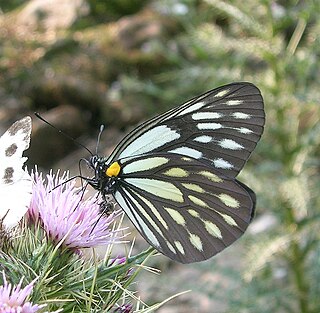 W
WAporia agathon, the great blackvein, is a mid-sized butterfly of the family Pieridae, that is, the yellows and whites, which is found in Nepal, India, China and Southeast Asia.
 W
WAppias pandione is a butterfly in the family Pieridae. It was described by Carl Geyer in 1832. It is found in the Indomalayan realm.
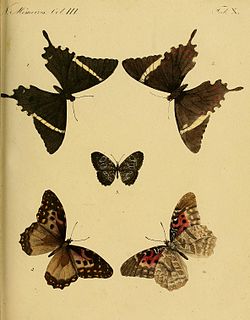 W
WArchimestra is a monotypic genus of nymphalid butterfly. It contains only one species, Archimestra teleboas, which is endemic to Haiti and the Dominican Republic.
 W
WArchon apollinaris is a species of butterfly in the family Papilionidae. It is found in Iran, Iraq, Syria, and Turkey.Seitz states-In the North-East of Asia Minor, Goman Olti, and in Armenia a usually smaller, pale and in both sexes sparsely marked mountain-form of Archon apollinus occurs, which is moreover characterized bya reduced marginal band of the hindwing; this is apollinaris Stgr. ; a dwarfed form of the female which is very deeply coloured in contrast to the ordinary form of the female of this subspecies may be called -ab. mardina, under which name it is already known in collections.
 W
WArhopala meander, the bright oakblue, is a butterfly in the family Lycaenidae. It was described by Jean Baptiste Boisduval in 1832. It is found in the Australasian realm.
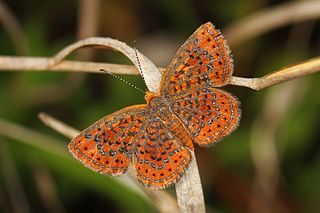 W
WCalephelis virginiensis, the little metalmark, is a species of metalmark in the butterfly family Riodinidae. It is found in North America.
Calisto archebates is a butterfly of the family Nymphalidae. It is endemic to Hispaniola, where it is found in the southern paleoisland's Sierra de Bahoruco.
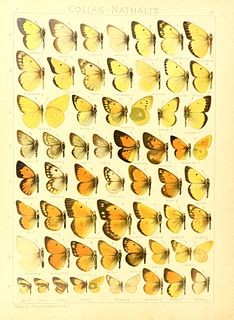 W
WColias nastes, the Labrador sulphur, is a butterfly in the family Pieridae. In Europe, it is found in the north of Norway and Sweden and on rare occasions in Northern Finland. It is also found in North America, specifically in Alaska, Canada, and the Rocky Mountains, Washington, Montana and on Greenland. In Asia, it is found in the Altai Mountains, the border regions of Russia, China, Mongolia, Kazakhstan, the Sayan Mountains, the north of Siberia, and in the Chukotka Autonomous Okrug.
 W
WColias thisoa is a butterfly in the family Pieridae. It is found in the mountains of the Caucasus, Transcaucasia, central Asia, southern Siberia, Turkey and Iran. The habitat consists of humid mountain meadows in the forest belt.
 W
WCyrestis camillus elegans is a butterfly subspecies in the genus Cyrestis and the family Nymphalidae. It is known from Madagascar.
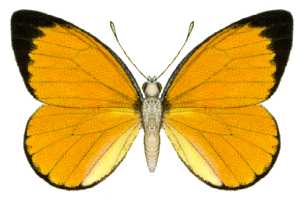 W
WDelias aruna, the golden Jezebel, is a butterfly in the family Pieridae. It is found in Queensland, Irian Jaya, Maluku, Papua New Guinea and several surrounding islands.
 W
WDelias bagoe is a member of the family Pieridae that lives in the Australasian realm. The caterpillars feed on Loranthaceae plants.
 W
WDelias gabia is a butterfly in the family Pieridae. It was described by Jean Baptiste Boisduval in 1832. It is endemic to New Guinea.
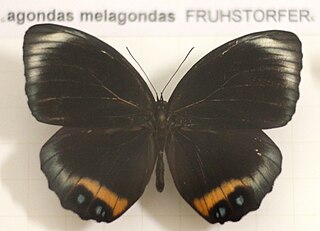 W
WElymnias agondas, the palmfly, is a butterfly in the family Nymphalidae. It was described by Jean Baptiste Boisduval in 1832. It is endemic to New Guinea and neighbouring Cape York in the Australasian realm.
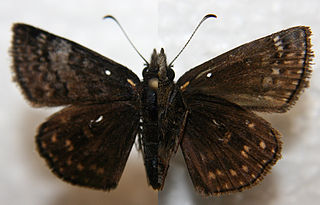 W
WErynnis brizo, the sleepy duskywing or banded oak duskywing, is a species of Hesperiidae butterfly that occurs throughout North America and is commonly confused with E. juvenalis and E. lucilius. The species is listed as threatened in Connecticut and Maine.
 W
WEumaeus atala, the Atala or coontie hairstreak, is a small colorful butterfly in the family Lycaenidae. It is found in southeastern Florida, the Bahamas, Cuba, the Cayman Islands, and probably on other Caribbean islands. Its coloration and habits are unique among butterflies within its range.
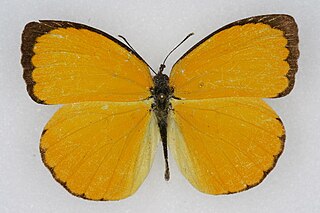 W
WEurema dina, the dina yellow, is a butterfly in the family Pieridae. The species was first described by Felipe Poey in 1832. It is found from Panama north to southern Florida. The species is regularly recorded from southern Texas and south-eastern Arizona. The habitat consists of forest edges, brushy fields and open forest.
 W
WThe Gavarnie ringlet is a member of the subfamily Satyrinae of the family Nymphalidae. It is a high-altitude butterfly found in France and Spain, notably at Cirque de Gavarnie in the Pyrenees National Park.
 W
WHeteronympha cordace, the bright-eyed brown, is a brown colored butterfly endemic to Australia. It was described by Carl Geyer in 1832.
 W
WIdea durvillei is a large butterfly that belongs to the danaid group of the family Nymphalidae. It was described by Jean Baptiste Boisduval in 1832. It is found in the Australasian realm. The name honours Jules Dumont d'Urville.
 W
WIphiclides feisthamelii, the southern scarce swallowtail, southern swallowtail or Iberian scarce swallowtail, is a butterfly found in Italy, Slovenia, southern France, Spain, Portugal, Morocco, Poland, Algeria and Tunisia. It is sometimes considered a subspecies of I. podalirius.
 W
WThe Jaeger's anetia is a species of nymphalid butterfly in the Danainae subfamily. It is found in the Dominican Republic, Haiti, and Jamaica.
 W
WJamides cyta, the pale cerulean, is a butterfly of the lycaenids or blues family. It is found throughout South-east Asia, from Malaysia to the Solomon Islands and the Philippines, as well as Queensland in Australia.
 W
WKretania pylaon, the zephyr blue, is a butterfly in the family Lycaenidae. It is found in southern Russia and the Middle East to Iran. The habitat consists of dry habitats.
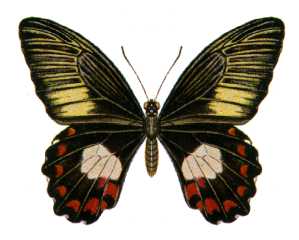 W
WPapilio ambrax, the Ambrax butterfly, is a butterfly of the family Papilionidae. It is found in Queensland, Australia, as well as the Aru Islands, Papua (Indonesia), and Papua New Guinea.
 W
WPseudochazara pelopea is a species of butterfly in the family Nymphalidae. It is confined to Lebanon, Turkey, the Caucasus, Syria, Turkmenistan and Kopet-Dagh.
 W
WPseudophilotes bavius, the Bavius blue, is a butterfly of the family Lycaenidae. It is found in Morocco, Algeria, Bulgaria, Romania, Greece, Asia Minor, southern Russia and northern Kazakhstan. The species occurs in small isolated populations on flower-rich, dry grassland, on dry, stony slopes and on open patches in shrub and in vineyards on calcareous soil.
 W
WPyrgus melotis, the Aegean skipper, is a butterfly of the family Hesperiidae. It was described by Philogène Auguste Joseph Duponchel in 1832. It is found in the Caucasus, Transcaucasia, Asia Minor, Greece and the Middle East. This is considered to be a subspecies of the Pyrgus malvae that was separated from the grizzled skipper by significant reproductive isolation mechanisms. The habitat consists of grasslands and slopes.
 W
WSpialia therapne, the Corsican red-underwing skipper, is a butterfly in the family Hesperiidae. It is found on the Mediterranean islands of Corsica and Sardinia.
 W
WTaractrocera papyria, the white-banded grass-dart, is a butterfly of the family Hesperiidae. It is found in the Australian Capital Territory, New South Wales, Queensland, South Australia, Tasmania, Victoria and Western Australia.
 W
WYpthima asterope, the African ringlet or common three-ring, is a species of Satyrinae butterfly found in most dry areas of Africa and Asia.